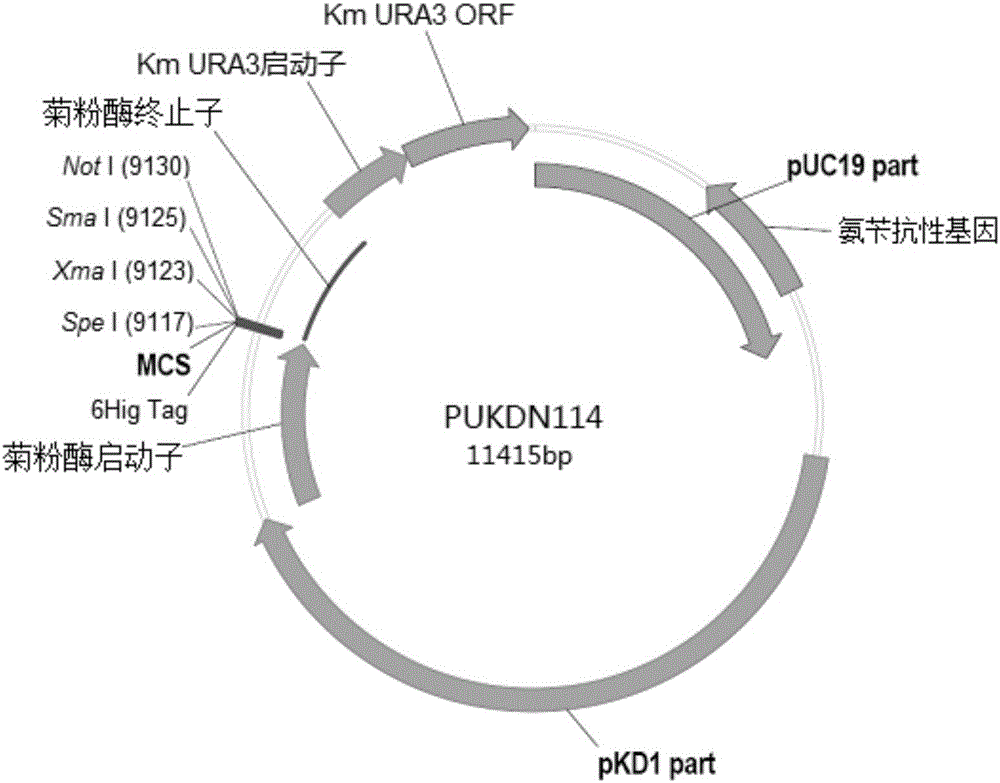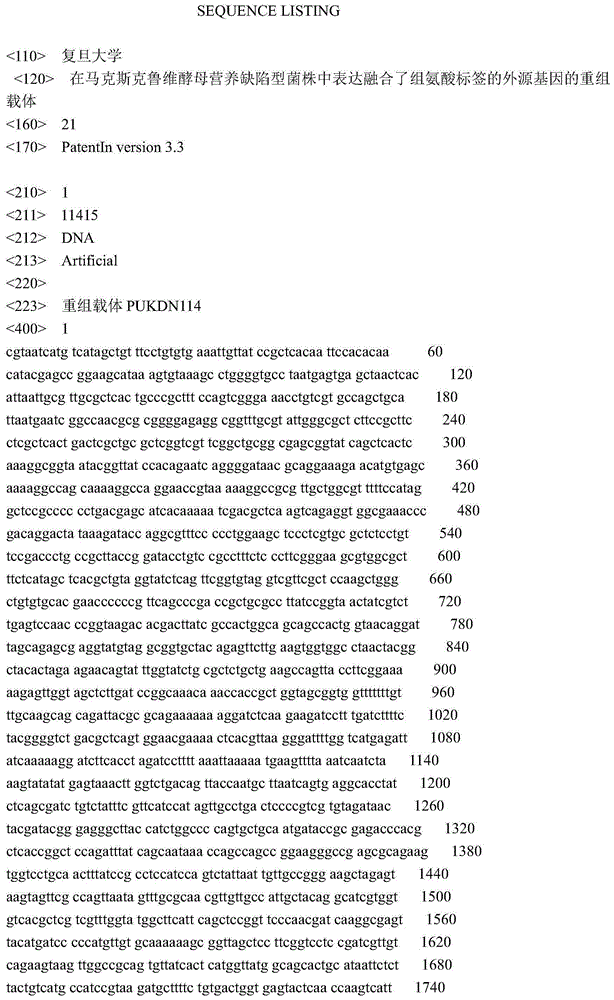Recombinant vector for expressing histidine-tag-fused foreign gene in Kluyveromyces marxianus nutritional deficient strain
A recombinant vector, yeast nutrition technology, applied in the direction of recombinant DNA technology, the use of vectors to introduce foreign genetic material, fungi, etc., can solve the problems of low expression level, low growth density, unsuitable for edible protein, etc.
- Summary
- Abstract
- Description
- Claims
- Application Information
AI Technical Summary
Problems solved by technology
Method used
Image
Examples
Embodiment 1
[0063] Embodiment 1, construction of recombinant vector PUKD114
[0064] Step 1. Amplify the pUC19 plasmid
[0065] Forward primer:
[0066] 5'-GAGGGGTACCGAGCTCGAATTAGCTCGAATTCGTAATCATGTCATAGCTGTTTCCT-3'
[0067] Reverse primer: 5'-TACAATTTTATGGTGCACTTCTCAGTACAATCTGCT-3'
[0068] The pUC19 plasmid was amplified using the primers. The PCR amplification reaction was carried out according to the instruction manual of PhantaSuperFidelityDNA Polymerase of Vazyme Company, the annealing temperature was 58°C, the extension time was 3 minutes, and 30 cycles. The PCR product was named as fragment A.
[0069] Step 2, amplify the pcYGW of the Gateway system vector
[0070] Forward primer: 5'-GAGTGCACCATAAAATTGTAAACGTTAATATTTTG-3'
[0071] Reverse primer: 5'-GCAAGCTTGGCACTGGCCGTCGTTTTACAACGTCG-3'
[0072] The pcYGW of the Gateway system vector was amplified using the primers. PCR amplification conditions were the same as step 1, except that the extension time was 1 min. The PCR ...
Embodiment 2
[0120] Embodiment 2, construction of recombinant vector PUKD116
[0121] Step 1, referring to Example 1, construct the PUKDN112 recombinant vector.
[0122] Step 2, Mutating PUKDN112
[0123] The PUKDN112 plasmid was mutated according to the instructions of the QuikChangeII kit of Agilent. The primers used for mutation are:
[0124] 5'-ATAAGTGACACATTTAATTTTTTTTTTTGTTAGATACTAGTCCCGGGGCGGCCGCTCACCATCATCACCACCATTAAGGCCGCAAGCTTTGATCTGATCTGCTTACTTTAC-3';
[0125] 5'-GTAAAGTAAGCAGATCAGATCAAAGCTTGCGGCCTTAATGGTGGTGATGATGGTGAGCGGCCGCCCCGGGACTAGTATCTAACAAAAAAAAAATTAAATGTGTCACTTAT-3'.
[0126] The mutated plasmid is PUKDN116. PUKDN116 was sequenced by Jieli Company to determine the 6HisTag sequence and multiple cloning sites. The sequencing primers are:
[0127] 5'-TCCCTTGAATCGTGTTTGCCAGTT-3'.
[0128] refer to figure 2 , the sequencing results are as follows:
[0129] Full length: 11412bp
[0130] 1031-1171bp: beta-lactamase (ampicillin resistance gene)
[0131] 3112-7870p: ...
PUM
 Login to View More
Login to View More Abstract
Description
Claims
Application Information
 Login to View More
Login to View More - R&D
- Intellectual Property
- Life Sciences
- Materials
- Tech Scout
- Unparalleled Data Quality
- Higher Quality Content
- 60% Fewer Hallucinations
Browse by: Latest US Patents, China's latest patents, Technical Efficacy Thesaurus, Application Domain, Technology Topic, Popular Technical Reports.
© 2025 PatSnap. All rights reserved.Legal|Privacy policy|Modern Slavery Act Transparency Statement|Sitemap|About US| Contact US: help@patsnap.com



